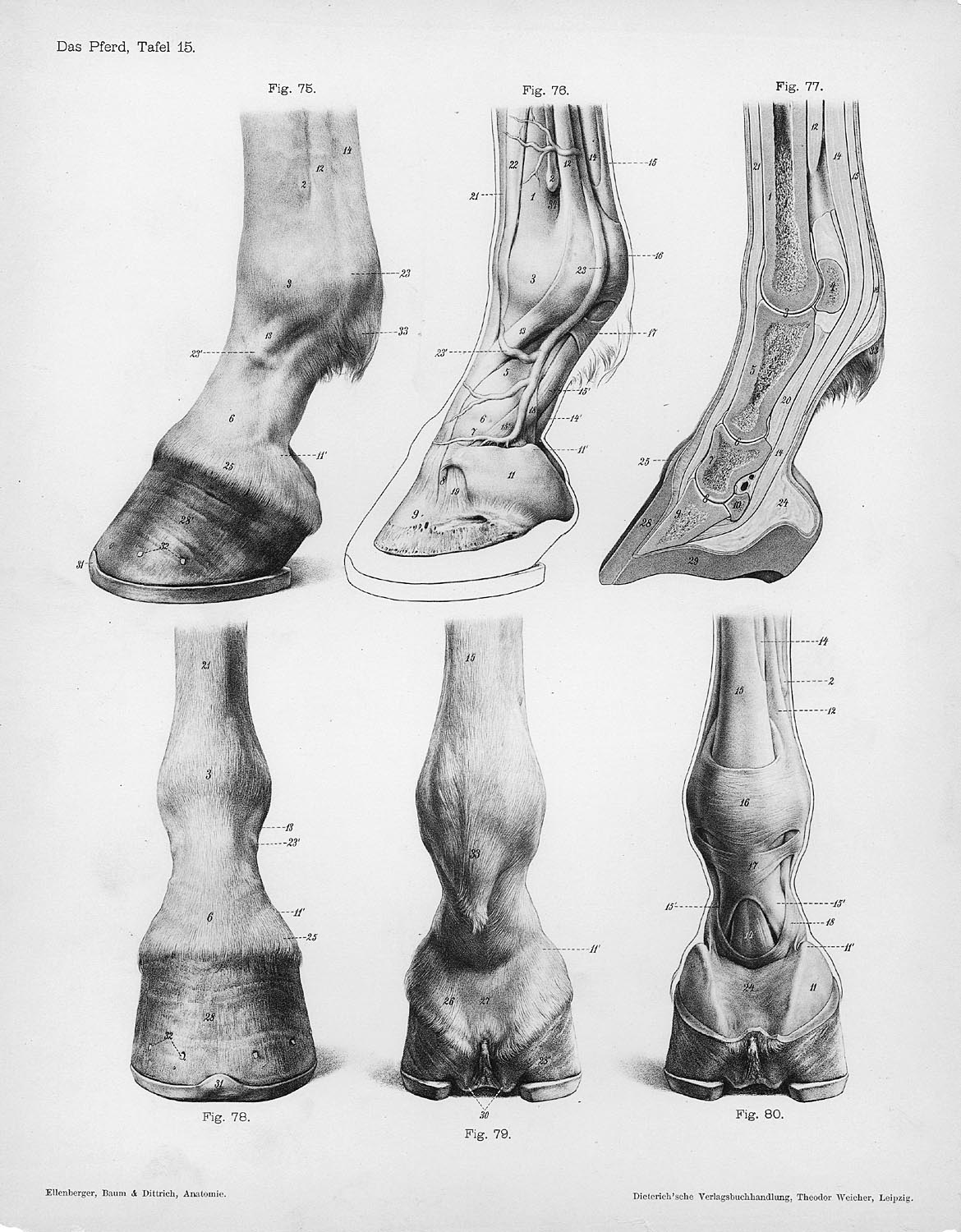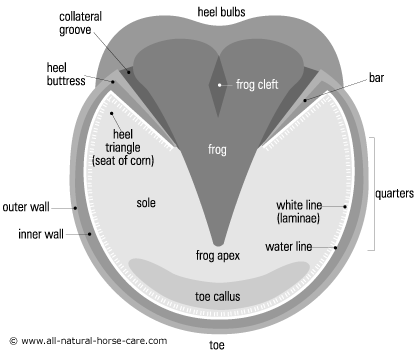So what do you look for? What does a properly trimmed/shod horse look like?
First, let's explore what happens to horses when hooves are not right. Symptoms manifest in the entire horse. Remember, hooves are your horse's foundation. Something happens to the hooves, it will affect the entire body of the horse.
Here are some clues that something is wrong:
-Irritability: I have seriously never met a horse that was downright nasty. I've met some horses that were hard to get along with. But every horse that I've come across that was "evil" had some sort of pain associated with it. What do I mean by evil or nasty? It depends on the horse. Some horses seem spitful; others will try a nip or two. If you are having problems in training, you may want to re-evaluate your horse's hooves. You could think it is just the horse's personality (sometimes it is) but rule out pain first. Sometimes a horse only shows pain with a tight eye or a tight lip.
-Lack of cadence: New horse owners may have a problem diagnosing this. Refining your eye to pick up slight nuances of movement is something not even some horseman 20 years in the business can do. If your horse is sound, my advice is to video tape your horse under saddle and at liberty (or lunge or roundpen). The best gait to find issues is at the trot. I find that 20 meter circles and straight-aways are key. A horse with heel problems will likely breakover quicker with the front feet, and land toe first. This means the horse must try to match this shortened stride in the the hind legs. A horse with toe problems will also break over quickly, but will land rather flat-footed. Again, the hindlegs are left compensating for the front legs not performing adequately. At the trot, the front leg and the hind opposite leg match each other. If you don't have a video camera, a neat trick you can do is wrap those matching legs in white polos, and the other two legs in pink or bright colored polos. The idea is to see if the legs are in perfect unison. If they're not, you have a problem. Like irritability, a lack of cadence does not necessarily mean you have hoof problems, but it is a good indicator. Here is a great video where you can see problems manifesting at the trot. This is Buttercup, she is sound, but her cadence is off at the trot: http://www.youtube.com/watch?v=9KBX6WnX_O8
-On/off lameness: it could be blamed on abcesses or a hard ride, but a horse experience on/off lameness is could be suffering from something more severe. An abcess usually resolves itself in about a week. If you are having symptoms for about a month, something could be wrong.
-Poor posture: a horse with hoof problems will stand with it's hind end tucked underneath it's belly or with it's front limbs tucked under it's torso. A comfortable horse (within the confines of its conformation) will stand with limbs perpendicular to the ground, in general.

(Picture ripped from google search. I'm not saying this horse has hoof problem, I'm only using it to demonstrate the forward-leaning posture that can indicate hoof problems. Though, looking at those toes are making me feel like this posture could be related to this Belgian's hooves.)
Now, the above indicators should help, even if you know absolutely nothing about hooves. I will do my best to try and explain it here. Remember, I'm a layman and not a professional. This is all new to me too. Your best bet is to seek the opinion of a vet or even an outside farrier (I've found that farriers are great about giving opinions on why the other guy is doing it wrong, but take it with a grain of salt as they are highly competitive and can be prone to exaggeration). Also, remember, vets are not necessarily qualified hoof experts. But at least seeking another professional's advice should give you some perspective.
Before I jump into this topic, last month's Practical Horseman had a great article on a properly shod horse. If you can get your hands on it, they did a great job of explaining.
OK, here are the essentials: you want the heel to extend underneath the heel bulb, you want to heel angle to match the hoof angle, and you want the angle of the hoof to match the angle of the patern. Sounds simple, right? Well, not really.
Farrier work is an art, not a science. If it was a science, we wouldn't have so many issues. Every horse is unique. Some horses have a 55 degree slope on their hooves, others have 47 degrees. It is whatever is comfortable with their conformation (this is why I listed some non-hoof indicators above).
Since mankind domesticated horses, we have had a need for farriers. Domestic-bred horses have no natural selection to prevent animals with poor hooves from breeding and no natural elements to keep their hooves worn. However, if you think that feral (truly wild horses no longer exist as the Przewalski's horses were returned to the wild from a zoo-kept breeding program) horses do not experience hoof problems, you're wrong. Ask any BLM organization. They may have tough hooves and are less prone to problems, but issues exist.
Just the other day, a feral horse near where I live turned up three-legged lame. My guess is abcess, but I haven't heard the official diagnosis.
So, let's get back to generalizations. You'll also notice that I'm really focusing on front hooves in my posts. With a horse's weight being mostly on the front end, this is where most hoof issue crop up, but don't neglect those hind hooves!
(removed picture of "balanced" barefoot hoof)
A properly balance shod hoof:

One thing you'll notice is that this is an artist sketch. This is an ideal. Hooves often don't follow the ideal, even when perfectly shod or trimmed.
Now, what should the hoof look like from the bottom?

By the way, if you are having a hard time doing your own research on what is healthy/normal and what isn't. I'd like you to know that it took me about an hour to find the meagar pictures in this post. You aren't alone.
The purpose of the blog is to help you become an advocate. To be an advocate, you need at least a basic understanding. But how can you get an understanding if you don't have the proper tools at your disposal? The system is rigged, and not in your favor.
So, your hooves don't look like the ideal AND your horse is exhibiting the above symptoms? Start asking your farrier questions. Ask everybody questions. Your friend, your barnowner, the vet. If you don't know, here is no harm in asking. Most farriers don't mind you asking why your horse's hooves don't look right. In fact, if he is good, he'll most likely explain it has something to do with your horse's conformation. Other times, it can open up dialogue. A static horse may be trimmed one way, but need to be trimmed another way once he is in motion, and your farrier may not see the entire picture.


I personally wouldn't call that barefoot hoof well balanced. Still LT/LH. Not to mention the hoof/pastern angle is off.
ReplyDelete